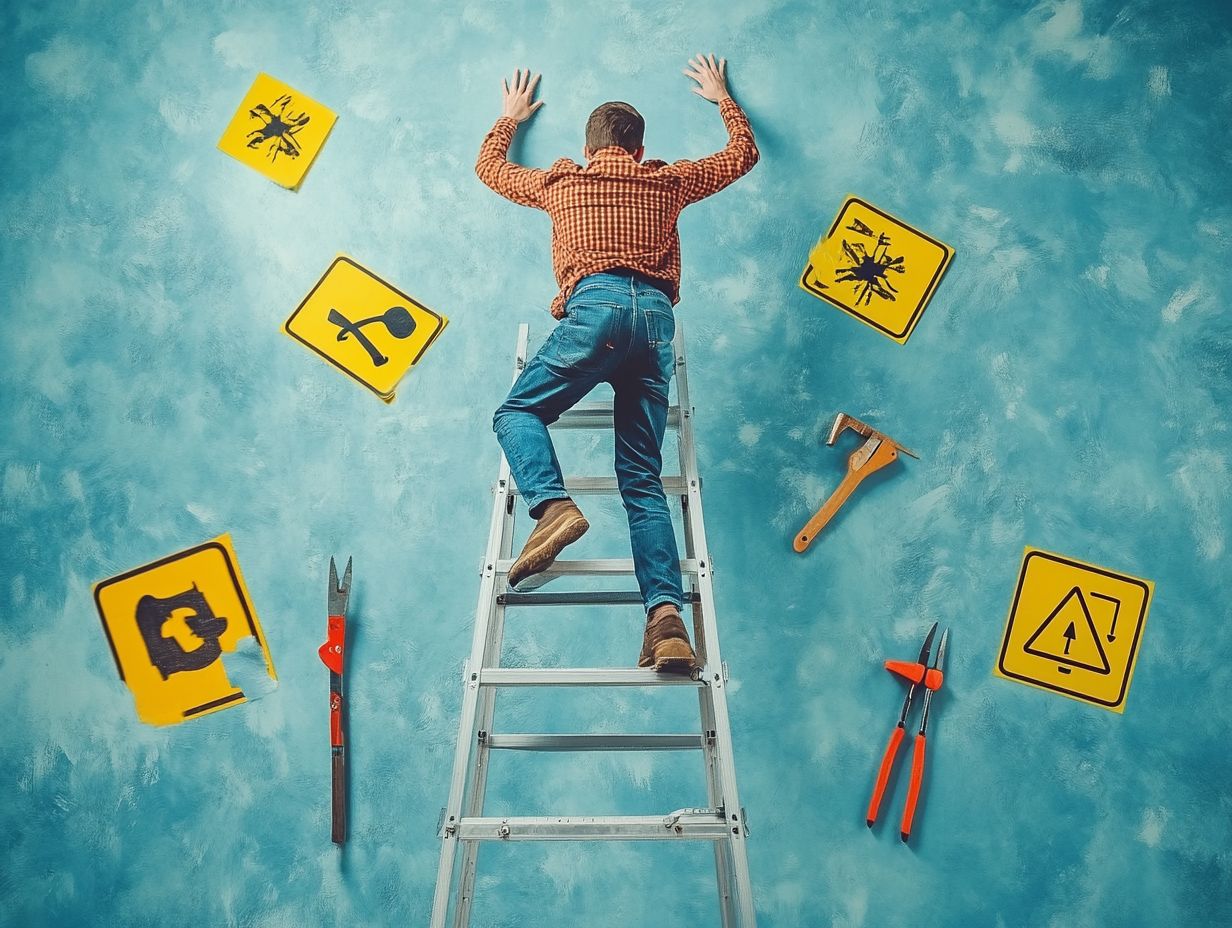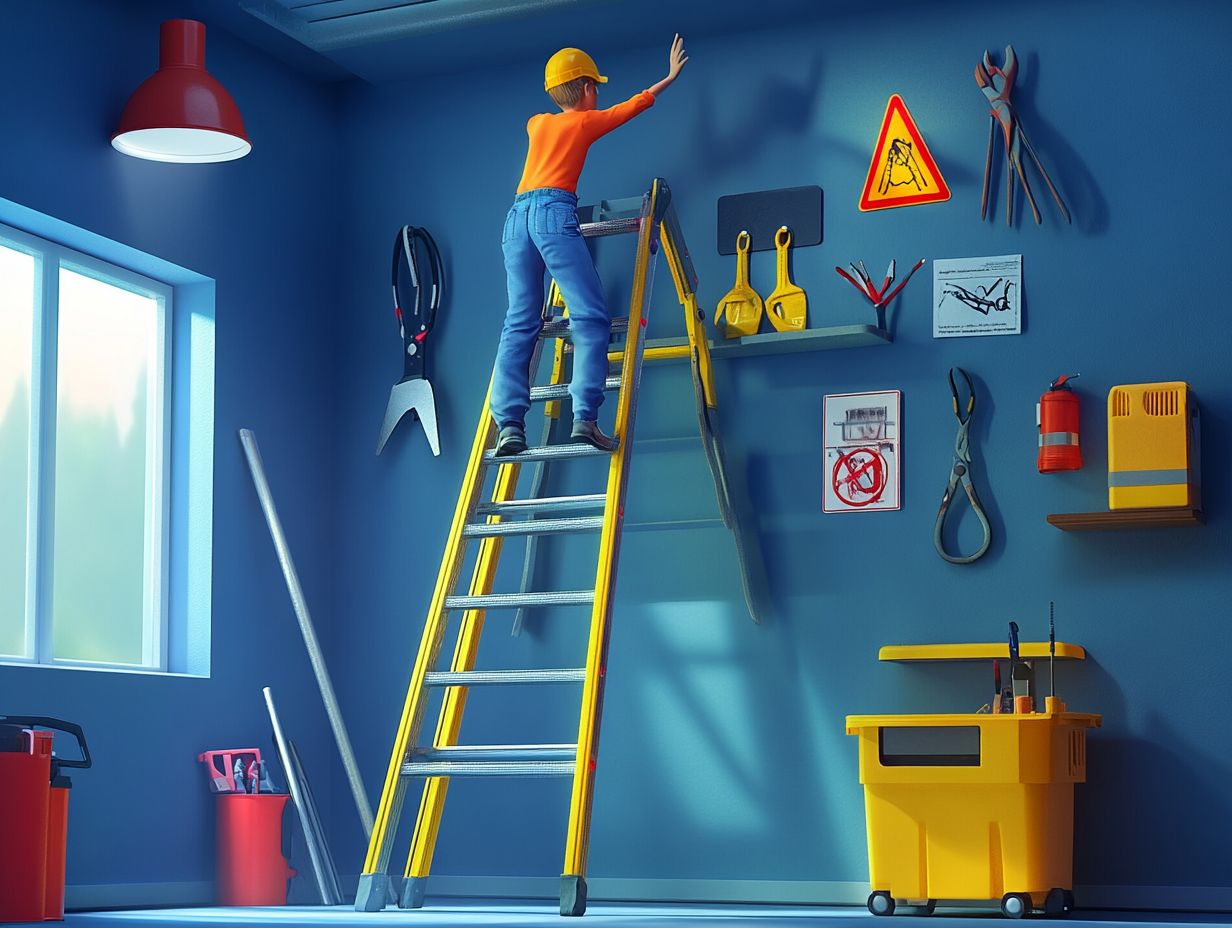Ladder safety is critical for anyone working at heights, whether you’re a seasoned professional or a weekend DIYer. Unfortunately, many people overlook basic safety guidelines, leading to accidents that are often entirely avoidable.
In this article, we’ll highlight the ten most common ladder mistakes people make—from choosing the wrong type of ladder to using unsafe climbing techniques. Along the way, we’ll share practical tips to help you steer clear of these errors and ensure every climb is a safe one.
Why Ladder Safety is Important

Ladder safety is of paramount importance as it significantly mitigates the risk of ladder-related injuries, which can result in serious accidents and fatalities. In both workplace and home settings, it is essential to understand the proper use of ladders, adhere to safety precautions, and comply with OSHA regulations to prevent accidents.
By prioritizing ladder safety awareness and implementing comprehensive safety protocols, individuals can foster a safer environment while utilizing various types of ladders, such as extension ladders and step ladders. Training and education on proper ladder handling techniques are critical for all users, ensuring they comprehend ladder weight capacity and the significance of ladder maintenance for reliability and stability.
Statistics indicate that falls from ladders contribute to a considerable number of workplace injuries, with thousands occurring annually, often resulting in severe injuries or fatalities. This concerning trend highlights the necessity for comprehensive training programs that educate users on injury prevention techniques and the appropriate use of common ladder safety equipment, including stabilizers and harnesses.
Compliance with OSHA regulations not only ensures adherence to legal standards but also cultivates a culture of safety, encouraging regular inspections and maintenance checks. By promoting an understanding of these preventive measures, users can significantly reduce risks and enhance safety in the working environment.
Common Ladder Mistakes
Understanding common ladder mistakes is essential for ensuring user safety and preventing accidents during ladder usage. Many individuals tend to overlook important factors such as ladder stability and proper positioning, which can lead to hazardous situations that may result in serious injuries.
By identifying these mistakes and implementing appropriate ladder safety measures, users can significantly improve their safety practices and decrease the likelihood of accidents. Issues such as improper ladder setup, neglecting ladder inspection protocols, and failing to comply with established ladder usage guidelines contribute to numerous ladder-related incidents annually.
Therefore, it is imperative to recognize and address these errors effectively.
Mistake #1: Using the Wrong Type of Ladder
Utilizing the incorrect type of ladder is a common error that can jeopardize safety and potentially result in serious accidents. Different ladder types are designed for specific purposes, and it is essential to understand which ladder is appropriate for particular tasks to ensure safety.
For example, individuals may mistakenly confuse a folding ladder with a multi-position ladder, which is intended for versatile use in various configurations. Each type of ladder possesses unique advantages, ranging from the stability of a platform ladder suitable for heavier tasks to the lightweight design of a step stool for indoor activities.
It is also imperative for individuals using ladders to consider the significance of proper ladder safety equipment, such as harnesses and non-slip footwear, to enhance stability and minimize hazards. By meticulously selecting and appropriately utilizing a ladder that is suited to the task at hand, individuals can substantially decrease the risk of accidents and foster a safer working environment.
Mistake #2: Not Checking for Defects

Failing to inspect a ladder for defects prior to use is a significant oversight that can lead to accidents. Conducting regular inspections of the ladder is essential to confirm that it is in good condition and free from any damage or wear that could compromise its stability.
It is advisable for users to incorporate a ladder safety checklist into their routine to identify potential issues such as frayed ropes, bent rungs, or loose screws. This proactive approach to ladder maintenance not only extends the lifespan of the ladder but also significantly enhances overall safety.
Certain components warrant special attention during inspections, particularly the locking mechanisms and the feet of the ladder, which are critical for stabilizing the structure during use. Additionally, checking for signs of corrosion or rust, especially on metal ladders, is crucial, as these factors can greatly undermine the integrity of the equipment. Regular cleaning of the ladder and proper storage also contribute to its longevity and functionality.
By prioritizing ladder safety and maintenance, users can avoid unnecessary hazards and ensure preparedness for any situation that requires elevation.
Mistake #3: Placing the Ladder on an Unstable Surface
Placing a ladder on an unstable surface constitutes a common and hazardous error that can result in falls and serious injuries. Proper ladder placement is essential to ensure that the ladder remains stable and secure during use. Users should always identify a flat, solid surface for setting up their ladders and confirm that the footing provides optimal support. Implementing ladder safety guidelines can further educate users on the significance of maintaining a stable base and avoiding conditions that may compromise ladder stability.
To attain the highest level of safety, individuals should also utilize the ladder’s levelers, if available, to adapt to any uneven terrain. Furthermore, it is important to position the ladder at the correct angle; a ratio of 4:1 is recommended, meaning that for every four feet of ladder height, the base should be one foot away from the wall. Additionally, it is advisable to secure the ladder against a sturdy surface or employ a stabilizer to prevent any unintended movement.
Regular inspection of both the ladder and its surroundings significantly mitigates the risk of accidents, thereby ensuring a safer experience.
Mistake #4: Overreaching
Overreaching while on a ladder is a common error that significantly increases the risk of losing balance and falling. Proper climbing techniques dictate that individuals should always maintain three points of contact when ascending or descending ladders, which greatly enhances stability.
It is essential to position the ladder at the correct angle and to refrain from stretching beyond one’s reach, as these actions can compromise safety and lead to accidents. By adhering to effective ladder positioning techniques, users can ensure safer operation and mitigate the risks associated with overreaching.
It is imperative for individuals to conduct regular inspections of their ladders for any signs of wear and damage, as faulty equipment can exacerbate the dangers of overreaching. When working at height, individuals should remember to keep their bodies centered on the ladder, utilizing their core muscles to maintain balance while performing tasks.
Employing tools such as tool belts or hoisting systems can further reduce the temptation to overreach, facilitating a more secure and controlled climbing experience. Prioritizing safety and proper techniques not only protects the climber but also fosters a culture of awareness regarding ladder safety in any workplace or home environment.
Mistake #5: Not Using Proper Climbing Techniques

The failure to utilize proper climbing techniques constitutes a significant oversight that can lead to falls and other ladder-related injuries. It is imperative for individuals to familiarize themselves with safe climbing practices, such as maintaining three points of contact at all times while on the ladder. This approach ensures that the user remains balanced and secure throughout the climbing and descending process. Moreover, implementing ladder safety tips can further enhance an individual’s awareness of safe climbing methodologies and techniques.
Additionally, understanding the various types of ladders is crucial, as different ladders serve distinct purposes and possess unique safety features. For example, it is essential to focus on the load capacity of the ladder and ensure that it aligns with the intended task to prevent accidents resulting from overloading. Regularly inspecting the ladder for any signs of damage, such as cracks or bent rungs, prior to use can significantly mitigate the risk of injury.
Practicing proper positioning—such as placing the ladder on stable ground and securing it against a wall—provides an additional layer of defense against falls. By incorporating these safety practices, individuals not only enhance their own safety but also improve the efficiency and effectiveness of their climbing activities.
Mistake #6: Not Securing the Ladder
Failing to secure a ladder properly before use is a prevalent oversight that can result in serious injuries and falls. It is essential to implement effective ladder securing techniques, such as utilizing stabilizers or anchoring the base to prevent any movement while climbing.
Employing appropriate ladder safety equipment can significantly enhance stability and safety when working at elevated heights. By ensuring that the ladder is adequately secured, individuals can substantially reduce the risk of accidents and create a safer working environment.
There are several methods to achieve this level of security. For example, ladder stabilizers can be attached to the top of the ladder, providing additional support against the wall or surface on which it rests. Securing the ladder against a solid structure or employing tie-downs can effectively mitigate lateral movement. It is also crucial to inspect the ladder for any defects and to confirm that the work surface is stable and level.
Additionally, wearing harnesses and helmets when appropriate reinforces a proactive approach to safety.
Ultimately, these efforts to secure ladders not only safeguard the user but also promote a culture of safety throughout any project.
Mistake #7: Using a Damaged Ladder
Utilizing a damaged ladder constitutes a significant safety risk that can result in severe accidents and injuries. Regular inspections of ladders are essential to identify any damages or wear that may not be immediately apparent.
Users should adopt the practice of conducting comprehensive ladder safety checks and performing necessary maintenance to ensure that the ladder remains in optimal condition before each use. This proactive approach not only helps prevent accidents but also extends the service life of valuable equipment.
Incorporating ladder maintenance into a regular safety routine can substantially reduce the risks associated with defective equipment. By systematically inspecting for issues such as loose rungs, rust, or bent frames, individuals can safeguard not only their own safety but also that of those around them.
Devoting just a few minutes to assessing the integrity of a ladder can provide peace of mind and assurance that it will safely support them during any task. It is important to remember that ladder safety checks are not merely a precaution; they represent a critical component of maintaining workplace safety standards and preventing unnecessary injuries.
Mistake #8: Ignoring Weight Limits

Disregarding the weight limits specified for a ladder constitutes a significant error that may result in collapses and serious injuries. Each ladder is equipped with a designated weight capacity that must be strictly observed to ensure safety during use.
When individuals recognize the importance of these limits, they are better positioned to make informed decisions regarding the appropriate ladder for specific tasks. For example, a lightweight ladder may be suitable for minor household tasks, while more demanding activities, such as roofing or extensive painting, may necessitate a more robust model.
Users should also take into account the weight of their tools and materials, as these additional loads can quickly accumulate. By accurately assessing both their personal weight and any supplementary loads, individuals can uphold safe handling practices and significantly mitigate the risk of accidents or injuries associated with improper ladder use.
Mistake #9: Not Using Personal Protective Equipment
Neglecting to utilize personal protective equipment (PPE) while working with a ladder represents a significant oversight that can elevate the risk of accidents. Appropriate ladder safety gear, including helmets, slip-resistant shoes, and harnesses, is essential for enhancing safety during ladder operations.
By adopting safety precautions and wearing the requisite PPE, individuals can substantially reduce the likelihood of injury while climbing or working at elevated heights. It is imperative for users to acknowledge the importance of incorporating safety gear into their ladder usage practices.
When individuals prioritize the use of PPE, they are better prepared to address the inherent hazards associated with work conducted at heights. Helmets offer critical protection from falling objects, while slip-resistant shoes mitigate the risk of slips and falls on the ladder rungs. Harnesses, particularly those that securely connect to a ladder or scaffolding, provide additional support and stability, ensuring that users remain anchored and secure throughout their tasks. Utilizing safety glasses to protect the eyes from dust and debris further contributes to a comprehensive approach to ladder safety.
By adopting these essential safety measures, ladder users not only protect themselves but also establish a standard for safety awareness within their work environments.
Mistake #10: Not Following Manufacturer’s Instructions
Failing to adhere to the manufacturer’s instructions for ladder use represents a significant oversight that can lead to operational errors and hazards. Each ladder is accompanied by a user manual that outlines essential safety guidelines and best practices specifically tailored for that particular model.
By diligently following these guidelines, users not only enhance their own safety but also safeguard those around them. The manufacturer’s recommendations typically include important details regarding weight limits, proper setup angles, and step placement, all of which are critical for maintaining stability during use.
Disregarding these instructions can diminish the ladder’s effectiveness and elevate the risk of falls or injuries. Additionally, properly executing the maintenance procedures outlined in the manual ensures the ladder’s longevity.
Consequently, understanding and implementing these safety measures transforms a routine task into a secure and efficient endeavor, ultimately fostering a safer environment.
How to Avoid These Mistakes
To mitigate common ladder-related mistakes, it is essential to implement effective ladder usage guidelines and participate in comprehensive ladder safety training. Developing a thorough understanding of ladder best practices enables users to operate ladders safely and with confidence.
This comprehensive approach encompasses familiarization with various ladder types, proper ladder placement, and strict adherence to safety guidelines and protocols. By taking preventive measures and prioritizing education on ladder safety, individuals can significantly reduce risks and enhance their overall safety when working at heights.
Tips for Safe Ladder Use
Implementing effective ladder safety measures is essential for ensuring safe ladder usage and minimizing the risks of falls. Key practices include proper ladder positioning techniques, maintaining the correct angle, and utilizing fall protection measures when working at elevated heights.
Users must ensure that the ladder is stable and secure prior to ascent, verifying that the footing is solid and slip-resistant. Adopting these practices not only enhances personal safety but also fosters a culture of ladder safety awareness among colleagues.
Individuals should conduct thorough inspections of their ladders for any signs of damage or wear before use, as such issues can significantly compromise stability. It is advisable to place the ladder on a flat, level surface and to maintain three points of contact while climbing—either two hands and one foot, or two feet and one hand. Additionally, wearing appropriate footwear can aid in preventing slips.
To further enhance safety measures, individuals should consider using harnesses or other fall protection equipment, particularly when working at greater heights, as these precautions serve as crucial safeguards. Prioritizing ladder safety not only protects individual users but also ensures the safety of those in the immediate vicinity.


